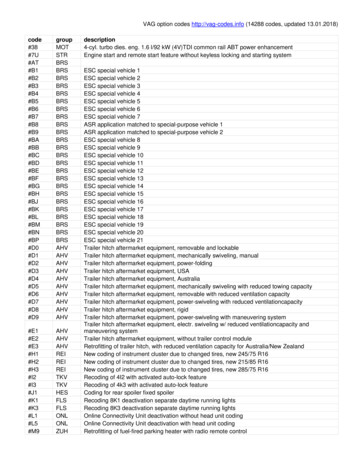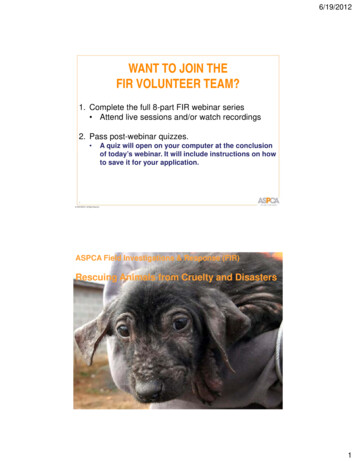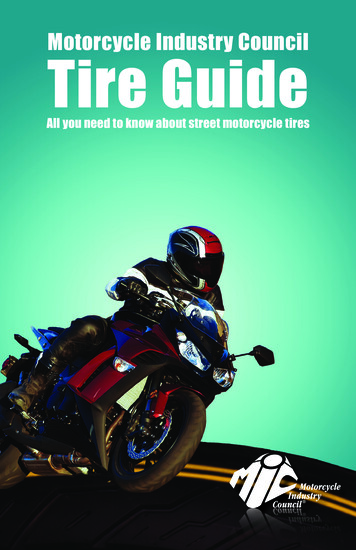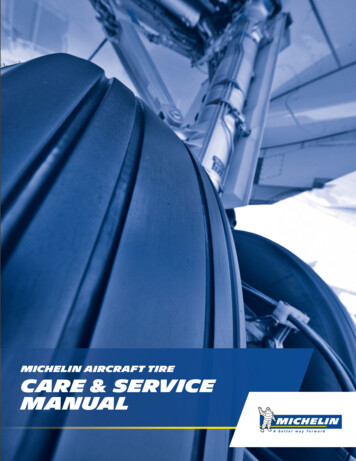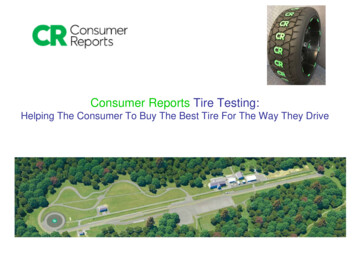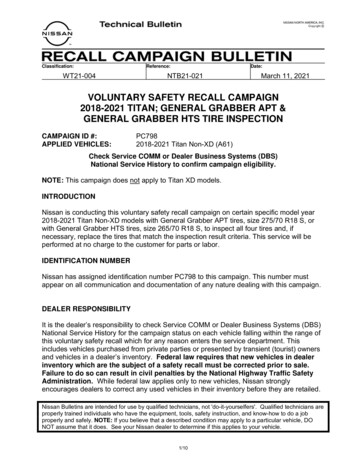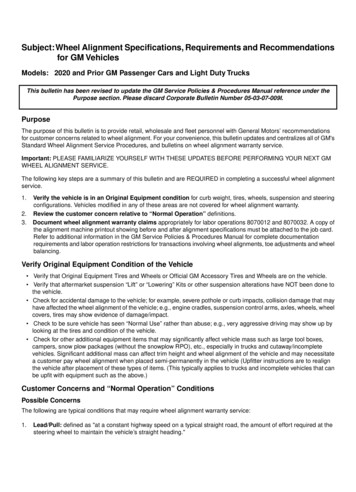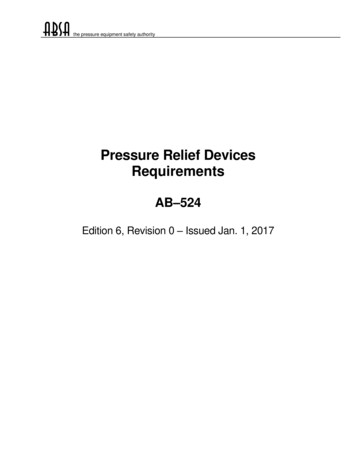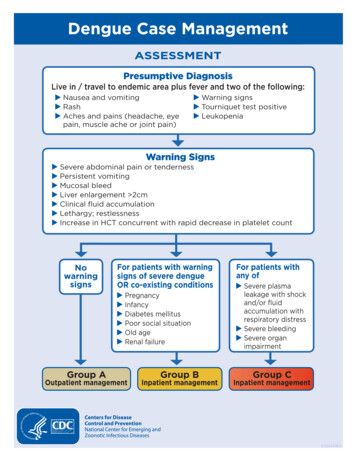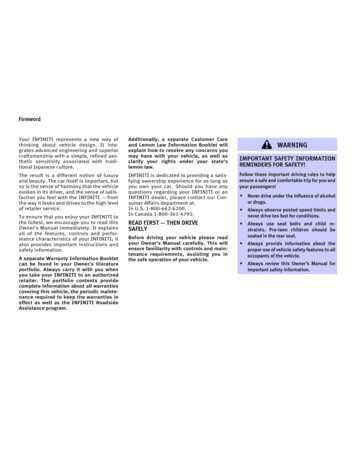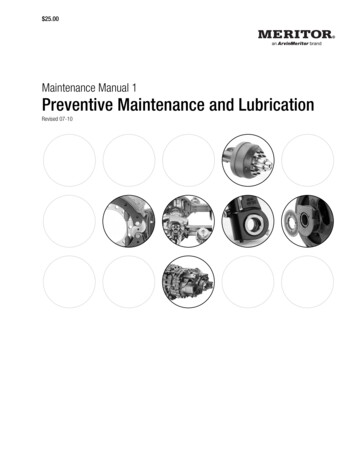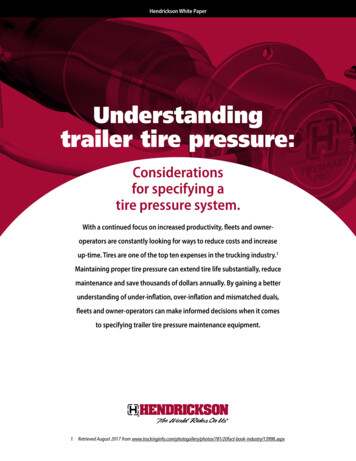
Transcription
Hendrickson White PaperUnderstandingtrailer tire pressure:Considerationsfor specifying atire pressure system.With a continued focus on increased productivity, fleets and owneroperators are constantly looking for ways to reduce costs and increaseup-time. Tires are one of the top ten expenses in the trucking industry.1Maintaining proper tire pressure can extend tire life substantially, reducemaintenance and save thousands of dollars annually. By gaining a betterunderstanding of under-inflation, over-inflation and mismatched duals,fleets and owner-operators can make informed decisions when it comesto specifying trailer tire pressure maintenance equipment.1. Retrieved August 2017 from t-book-industry/13998.aspx
THE PROBLEMTires represent the most important maintenance item on a trailer. Theyremain the number one reason for trailer breakdowns, weighing in at48 percent of road calls, according to a published survey by Federal MotorCarrier Safety Administration (FMCSA). It is also estimated that up to 85percent of blowouts could be prevented if tires were properly inflated.2While the number one problem with trailer tires is under-inflation, overinflation and mismatched duals also account for their share of trouble.Let’s look at the specifics associated with each condition.“Alligators(black shards ofrubber seen alongthe highway)are extreme examplesof tire disintegrationcaused byunder-inflation”Under-InflationIn its Confidence Report on Tire Pressure Systems, the North American Council for FreightEfficiency (NACFE) cited reports with some startling statistics:3 About one in five trailers operate with one or more tires under-inflated by at least 20 pounds persquare inch (psi) 3 percent of all trailers operate with four or more tires under-inflated by at least 20 psi 3 percent of all trailers operate with at least one tire under-inflated by 50 psi or moreStatistics from research by The Technology & Maintenance Council’s Tire & Wheel Study Group ontire pressure were also revealing:4 Only 44 percent of all tires were inflated to within 5 psi of their recommended inflation pressure 22 percent had at least one tire under-inflated by 20 psi or more Four percent of all vehicles had at least one flat tire, defined as 50 psi below the recommended pressure Approximately 7 percent of all tires in truckload and less than load (LTL) fleets are under-inflated by20 psi or moreWhy is under-inflation such a concern? Under-inflation results in sidewall deflection, generating excessheat and weakening the internal tire structure, called the carcass. If the tire carcass is damaged, retreadingthe tire is no longer an option, which can add hundreds of dollars to the cost of servicing each tire. Evenif the carcass is spared, the heat and deflection of an under-inflated tire leads to increased wear, reducedlife and a corresponding drop in fuel economy. Zipper rips and the dreaded “alligators” (black shards ofrubber seen along the highway) are other extreme examples of tire disintegration caused by under-inflation.Over-InflationOver-inflation is also a pertinent problem in the trucking industry. The same FMCSA study noted abovefound that 16 percent of all trailer tires are over-inflated by more than 5 psi and 5 percent by more than10 psi. Over-inflated tires are not necessarily the result of drivers or maintenance professionals addingtoo much air. The most common reason for over-inflation is elevated tire operating temperaturescombined with increased ambient air temperature. The TMC Recommended Practice RP 235 states thattire pressure can increase by 10 to15 percent because of warm-up.5 Although tires are designed to functionwith pressure variations from warming during normal use, pressure effects resulting from ambienttemperature fluctuations are a different story.Another potential cause of elevated tire temperatures can be attributed to some tire inflation systems.Tire inflation systems that are only capable of inflating tires will add air pressure to tires anytime theambient air temperature drops. This includes low temperature extremes to which the vehicle is exposed.When the vehicle returns to a warmer environment, the pressure in the tires increases above the targetpressure.22. Retrieved August 2017 from cle-tire-condition-sensors3. Retrieved August 2017 from Confidence-Report1.pdf4. Retrieved August 2017 %202010-2.pdf5. Retrieved August 2017 from trucking-associations
Over-Inflation (Cont’d)The increase in pressure caused by both use and ambient temperature typically cannot bleed offat the same rate that it increases. Natural air loss due to diffusion through the tire casing is onlyestimated to be 1 to 2 psi per month at normal operating pressures, thus resulting in over-inflation.Over-inflated tires are harder than properly inflated tires, making them more susceptible to tread surfacecutting, punctures and impact breaks. Over-inflation also changes a tire’s footprint, which can affect tiretraction and lead to irregular wear patterns. TMC Recommended Practice RP 219B, Radial Tire WearConditions and Causes, indicates that the probable cause of excessive wear found on both shoulder ribsof trailer tires in the study was likely over-inflation.6 The edges of an over-inflated tire pull away fromthe ground and only make contact when they skip across road imperfections, or when the tire bounceswith enough force to press the edges into brief contact with the road. That scuffing of the rubber causesrapid and irregular edge wear. This accelerated tread wear can cost 7 to 15 percent of the tire life.Mismatched DualsTrailer tires that work in a dual configuration are intended to share the load equally. They should be thesame size and diameter and have the same tread pattern. Equal inflation pressure is optimal but tiremanufacturers recommend that they are at least within 5 psi of each other. However, research indicatesthat reality is quite different. The TMC Tire & Wheel Group Study found that 22 percent of all dual tiresinspected had mismatched air pressure with a difference of more than 5 psi. Similar findings were statedin the FMCSA Report, with one out of four trailer dual assemblies (25 percent) having tires that differed inpressure by 5 psi or more. So, the issue of mismatched dual pressures is real and often goes both unnoticedand unaddressed. Within a matter of weeks, mismatched pressures can cause permanent irregular wearpatterns, which can lead to early tire removal.Testing has shown that a 5 psi difference between dualscreates a 5/16-inch difference in tire circumference. Ingeneral, a tire makes about 500 revolutions per mile.In 100,000 miles, that is 50 million rotations, which equates95 PSIto a difference of 246 miles between the two dual tires.So it’s as though the smaller tire drags against the pavementat highway speeds for 246 miles, resulting in rapid andirregular wear. The tire with the larger circumference alsolikely suffers from internal damage from the braking force100 PSIof the smaller tire which can also result in premature wear.Tires that are not matched properly will also have aExample of Distance Traveled of Mismatched Dualsdifference in overall height. This causes the taller trailer tireto carry slightly more load than the smaller one. Ultimately,failure to properly equalize dual tire pressures can lead to unequal tread wear for both tires.THE CONSEQUENCESThere are many consequences associated with trailer tires operated at improper tire pressure. Let’s takea closer look at the significant impact it can have on fleets and owner operators.Decreased Tire LifeTMC’s Recommended Practice 235A states that “a constant 20 percent under-inflation will increase treadwear by 25 percent, and a constant 10 percent over-inflation will increase tread wear by 5 percent.” 7The increase in tread wear directly correlates to a decrease in tire life.6. Retrieved August 2017 from trucking-associations7. Retrieved August 2017 from trucking-associations33
Downtime Expense“.nearly half ofWith nearly half of all road calls being for tire-related issues, it’s no wonderall road calls areproper tire inflation is gaining more and more attention in the truckingfor tire-relatedindustry. In fact, according to TMC, improper inflation causes about oneissues”road call each year per tractor-trailer. The average out-of-pocket cost of atire-related road call could easily reach 900, and that is only the cost ofone new dual trailer tire and the associated service call. The total expensecould be much greater when factoring in things such as: distance from service provider, late freightpenalties, reduced shipper confidence and a reduction in available driver hours-of-service.8Reduced Fuel Economy According to TMC, 30 percent to 40 percent of the fuel required to move a vehicle down the highwayis spent overcoming tire rolling resistance. When tires are under-inflated, the amount of drag created bythe tires increases. This additional drag causes an increase in friction and heat and therefore an increasein fuel consumption. Conventional wisdom says vehicles running with tires under-inflated by 10 psi cansee a 1.5 percent decrease in fuel economy. That is equivalent of 415 per tractor per year in excess fuelcosts, using today’s diesel prices.CSA Violations and FinesUnder-inflated tires can result in a citation during a roadside inspection, as tire inflation is covered inthe CSA Maintenance BASIC. In fact, tires are among the top three components mostoften responsible for violations in the Maintenance BASIC, with a flat tire beingan eight-point deduction and an under-inflated tire being a three-pointdeduction. In addition, under-inflation is often responsible for muchof the tire damage inspectors see.GHG Phase 2FACTSADDITIONAL FACTORSGreenhouse Gas Phase 2 (GHG2)RegulationsThe recent release of phase two of the Greenhouse GasEmissions and Fuel Efficiency Standards for Medium- andHeavy-Duty Engines and Vehicles (GHG2), places an increasedfocus on technology that improves fuel efficiency and reducesgreenhouse gas (GHG) emissions for trailers used in combinationwith tractors. A recent report published by the InternationalCouncil on Clean Transportation (ICCT) estimates “fuel savingswill be over half a million barrels of oil per day in 2035, and by2050, when the rule is fully phased in, these savings increaseto over 800,000 barrels per day.” 9The GHG2 ruling can be overwhelming when trying to decipher.However, the requirements specific to trailers can be summedup fairly easily. All full and partial-aero box vans (dry andrefrigerated) are held to a performance-based compliancestandard. This means original equipment manufacturers (OEMs)of these trailer types can use a combination of low-rollingresistance tires, aerodynamics, weight savings and/or tirepressure system to meet the required carbon dioxide (CO2)emission spec. Non-aero box vans, liquid and gas tanks, straightflatbeds, and container chassis are held to a design-basedcompliance standard. Trailer OEMs of these styles are requiredto use low-rolling resistance tires and a tire pressure system;no calculation or equation is used.Effective January 1, 20181AFFECTED TRAILER CATEGORIESBOX TRAILERS Dry Vans Refrigerated VansNON-BOX TRAILERS Liquid and Gas Tanks Straight Flatbeds(Single continuous load-bearing surface) Container Chassis2COMPLIANCE STANDARDSPERFORMANCE-BASEDFull- and Partial-Aero Box TrailersCombination of low-rolling resistance tires,aerodynamics, tire pressure system and/or weightsavings that meet the required CO2 emission spec.Calculate using the compliance equation.DESIGN-BASEDNon-Aero Box Trailers and Non-Box TrailersRequires the use of low-rolling resistance tiresand a tire pressure system.3EXCLUSIONS All other vocational trailers not listed All trailers with 4 or more axles Trailers less than 35 feet long with 3 axles Trailers with fixed axle spread 120 inchesAERO DefinedFULL-AERO: Underside and rear of trailer are FREE ofany work-performing equipmentPARTIAL-AERO: Work-performing equipment is installedon underside OR rear of trailerNON-AERO: Work-performing equipment is installed onunderside AND rear of trailer8. Retrieved August 2017 from -preventing-blowouts9. Retrieved August 2017 from ns-FRM4
AVAILABLE METHODOLOGYThe importance of proper trailer tire inflation is clear. Fleet managers and owner operators continue tostruggle with finding ways to maintain proper tire inflation. However, by simply putting a little air in theright place at the right time can save both effort and expense on trailer operations. There are a varietyof ways to address the tire pressure issue. Below is a summary of the most commonly available intoday’s market.The DriverDrivers are the first line of defense for proper tire inflation. As part of their pre- and post-trip inspections,they should complete a visual inspection of all tires. Depending on the company’s maintenance policy,most drivers are expected to check actual tire pressures weekly. Drivers have indicated that pressurechecks can be time consuming and that the inside tire on a dual assembly is difficult to check. The FMCSAstudy indicates that it takes approximately 30 minutes to check tire pressures on an eighteen wheeler,which equates to 13 minutes per trailer, assuming tandem duals. This in turn, leads many to wonderhow often drivers truly are checking tire pressures.10Tire Pressure Monitoring SystemsTire pressure monitoring systems provide a direct measurement of pressure, and sometimes temperature,for each individual tire. The measured pressure is compared to a preset target pressure for a given vehiclewheel position. If the pressure differs from the target, an alert is issued. The alert can be in the form of avisual display at the wheel-end, or via the transmission of data to an in-cab display or a computer systemthat can be accessed by the fleet.Continuous tire pressure monitoring is the primary function of TPMS. If the system contains non-transmittingwheel-end sensors, then the operator must be diligent about performing walk-arounds and checking fora visual indication. Systems that have transmitting wheel-end sensors provide the added benefit ofautomatically transmitting tire pressure conditions at each wheel position to the operator and/or fleetmaintenance personnel.Tire pressure monitoring systems can be used on both tractors and trailers, which differentiates themfrom the other forms of pressure systems. However, they do not have the ability to provide air to or relieveair from the tires when incorrect pressures are detected. This activity still requires human intervention.Also, if the sensors are removed in the field for any reason, it is critical they are reinstalled on the originaltire location in order for them work properly and not send false alerts.Inflate-Only Automatic Tire Inflation SystemsAutomatic tire inflation systems (ATIS) monitor trailer tire pressure in comparison to a preset target pressureand automatically inflate trailer tires whenever the detected pressure is below the target. Typically, anATIS uses a status light to alert the driver that the system is delivering air to the tires. These systems donot report out actual tire pressures, nor can the driver adjust the system target pressure from inside thecab. Most ATIS draw air from vehicle-mounted, compressed-air tanks and these systems cannot managetractor tires. However, some draw air directly from the environment via a self-contained pump; thesesystems can be installed on truck drive axles. Either way, both styles are only capable of inflating tiresfound to be below the target pressure. They are unable to relieve air from over-inflated tires.Central Tire Inflation SystemsThe operation of a central tire inflation system (CTIS) is similar to ATIS, except that the driver has theability to adjust the target pressure from an in-cab display depending on the operating conditions ofthe vehicle. CTIS are typically found in off-road and military applications.Advanced Automatic Tire Pressure Control SystemsAn advanced automatic tire pressure control system is the next generation of ATIS for trailer tires. Thesesystems not only address under-inflated tires but also over-inflated tires. They automatically provide airto a tire found to be below the preset target pressure, and they can respond to changes in ambienttemperature by relieving air from a trailer tire found to be above a preset upper threshold. One specificadvanced automatic tire pressure control system also can equalize tire pressures across all wheelpositions. The primary advantage is that all of this is done automatically, with no driverintervention required.10. Retrieved August 2017 from cle-tire-condition-sensors5
THE SOLUTION -TIREMAAX PROThere are more options for trailer tire pressuremanagement than ever before. When selecting atire pressure system, owner-operators and fleetmanagers must determine which technology bestmeets their operational requirements and providesthe best return on investment. Hendrickson deliversa revolutionary solution with TIREMAAX PRO. It isan advanced automatic tire pressure control systemfor the trailer industry capable of active inflation,relieving and equalizing, minimizing costly tire wear,improving productivity and increasing fuel mileage.TIREMAAX PRO features a mechanical design that constantlymonitors tire pressure to respond to under-inflated tires andchanges in outside temperature that can cause over-inflatedtires. The patented system draws from the trailer air supply tohelp keep all the trailer tires properly inflated and rolling smoothly.PRO detects pressure dips below a preset level in one or more tiresand directs air to the affected tire(s). The system responds to changes inoutside temperature and prevents over-inflation by relieving air from the tires.This excess pressure flows back through the supply lines and exhausts at thecontroller. Finally, TIREMAAX PRO equalizes the pressure at all wheel positions byusing special valves in the hubcaps that allow air to flow both to and from the tires.This ability to equalize pressures reduces scrubbing between duals and improves tire TPMSInflate-only ATISTIREMAAX PROHendrickson is a recognized leader in the supply of suspension systems and components for the globalcommercial vehicle industry. That legacy continues with TIREMAAX PRO.6
TIREMAAX literature, website and microsite: L1199 TIREMAAX PRO brochure L1017 TIREMAAX Tire Inflation System flyer L878 TIREMAAX Parts List L868 TIREMAAX Ordering Guide T51002 TIREMAAX CP & PRO Technical ProcedureTIREMAAX Online: www.tiremaax.comTIREMAAX PRO ROI Calculator: www.hendrickson-intl.com/tiremaaxroiABOUT HENDRICKSONHendrickson is a leading global manufacturer and supplier of medium- and heavy-duty mechanical,elastomeric and air suspensions; integrated and non-integrated axle and brake systems; tire pressurecontrol systems; parabolic and multi-leaf springs; stabilizers; and bumper and trim components to the globalcommercial transportation industry. Everyday around the world, millions of Hendrickson suspensions carrycountless loads of freight and raw materials both on- and off-highway. We supply durable, lightweight,high-performing suspension systems and components to the major North and South American, European,Asian and Australian medium- and heavy-duty truck and trailer OEMs and fleets. Hendrickson’s growingglobal position in the commercial transportation industry and the on-going drive to provide productsand services benefits truck and trailer manufacturers, fleets and owner operators around the world.Our tagline, The World Rides On Us , not only reflects the spirit of the brand but also Hendrickson’s100 plus years of innovation, engineering advancements and manufacturing excellence.Trailer Commercial Vehicle Systems2070 Industrial Place SECanton, Ohio 44707-2641Information contained in this literature was accurate at the time of publication. Product changes may have been made after the copyright date that are not reflected.10 2017 Hendrickson USA, L.L.C. All Rights Reserved Printed in United States of America7
road call each year per tractor-trailer. The average out-of-pocket cost of a tire-related road call could easily reach 900, and that is only the cost of one new dual trailer tire and the associated service call. The total expense could be much greater when factoring in things such as: distance from service provider, late freight
